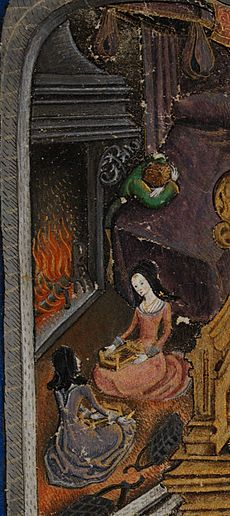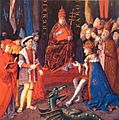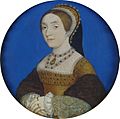Henry VIII facts for kids
Quick facts for kids Henry VIII |
|
|---|---|
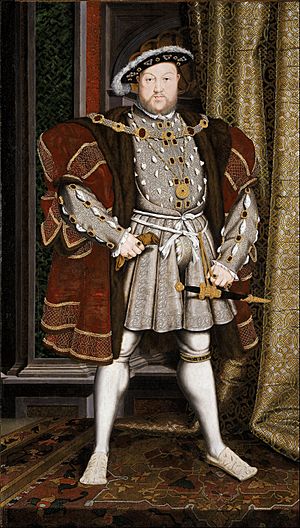
Portrait of Henry VIII after Hans Holbein the Younger, c. 1537–1562
|
|
| King of England King of Ireland (more...) |
|
| Reign | 22 April 1509 – 28 January 1547 |
| Coronation | 24 June 1509 |
| Predecessor | Henry VII |
| Successor | Edward VI |
| Born | 28 June 1491 Palace of Placentia, Greenwich, England |
| Died | 28 January 1547 (aged 55) Palace of Whitehall, Westminster, England |
| Burial | 16 February 1547 St George's Chapel, Windsor Castle, Berkshire |
| Spouse |
|
| Issue Among others |
|
| House | Tudor |
| Father | Henry VII of England |
| Mother | Elizabeth of York |
| Religion |
|
| Signature | |
Henry VIII (born 28 June 1491, died 28 January 1547) was the King of England from 1509 until his death. He is famous for having six wives and for his big disagreement with the Pope. This disagreement led to the English Reformation, which separated the Church of England from the Pope's power. Henry made himself the head of the new Church of England and closed down many monasteries. Because of this, the Catholic Church removed him from their community. Henry is also known as "the father of the Royal Navy" because he spent a lot of money to make the English navy much bigger and stronger.
Henry made many important changes to the way England was governed. He believed that kings had a special right from God to rule. He also made the king's power much stronger. Henry often used accusations of treason (being disloyal to the king) to stop people who disagreed with him. Many people accused of treason were executed. He had many important advisors, but some of them were also executed when they lost his favour.
Henry loved to spend money. He used money from the closed monasteries and from taxes that used to go to the Pope. Even with all this money, he often had financial problems. This was because he spent a lot on himself and on expensive wars with countries like France and Scotland. During his rule, England and Wales were legally joined together. He was also the first English king to rule as King of Ireland. Henry was seen as a smart and talented king by people at the time. His reign is considered one of the most important in English history. He was also a writer and a musician. As he got older, he became very overweight and his health suffered. He was succeeded by his son, Edward VI.
Contents
King Henry VIII's Life and Reign
Early Life and Education
Henry was born at Greenwich Palace on 28 June 1491. His parents were Henry VII of England and Elizabeth of York. He was one of their seven children, but only four lived past infancy. These were Arthur, Prince of Wales; Margaret; Henry; and Mary.
Young Henry had his own servants and musicians. He even had a "whipping boy" who would be punished when Henry did something wrong. Prince Henry loved music and was very good at it. By age 10, he could play many instruments, like the fife, harp, and drums. Henry was a good student, spoke several languages, and was athletic. He could speak Latin, French, and Spanish fluently. He had the best teachers and also learned skills like jousting, archery, and hunting. Henry was also very religious.
Henry's older brother, Arthur, was the next in line to the throne. This meant Arthur would become king after their father, Henry VII. Arthur married a Spanish princess named Catherine of Aragon. Sadly, Prince Arthur died a few months later when he was 15 years old. Henry was 10 at the time, and after Arthur's death, Henry became the next in line for the throne.
While his father was alive, Henry was watched very closely. The King was worried about his only remaining son's safety. Henry could only leave his room through a private door and was always watched by special guards. No one was allowed to speak to Henry unless his father asked them to. He spent most of his time in his room, which could only be reached through his father’s bedroom. Henry was careful not to show his lively personality in public because he feared his father's temper. He did not get much training for his future role as king. Because of this, he relied a lot on his advisors when he first became king. In 1509, Henry VII died, and 17-year-old Henry became King Henry VIII.
Becoming King
Three months after becoming king, Henry married Catherine of Aragon. They wanted to have children, especially a son, to ensure someone would inherit the throne. In 1511, Catherine gave birth to a son named Henry, but he died just seven weeks later. Later, she gave birth to a girl, who would become Queen Mary I. All her other children were stillborn, meaning they died before birth. Henry did have one son, Henry Fitzroy, with a woman he was not married to, but this son could not become king.
Early in his reign, Henry had two of his father's advisors executed. They were not popular, and Henry claimed they had stolen money. Henry often executed people he disliked throughout his time as king. From 1514, Thomas Wolsey became a very important advisor to Henry. Wolsey helped Henry change the government to give the king more power. Wolsey later became a cardinal, which made him a powerful figure in the church.
At first, Henry wanted to be friends with the King of France. But soon, he joined with Spain, the Pope, and the Holy Roman Empire to try and weaken France. He dreamed of gaining more land in France. England won some battles against France in 1513. This alliance also helped reduce France's power over the Pope. Scotland invaded England in 1514 but lost badly at the Battle of Flodden. However, Henry spent a lot of money and did not gain much land.
In 1520, a grand event called 'The Field of the Cloth of Gold' happened in Calais, which was then part of England. It was held to celebrate peace between France and England after a long war. A huge amount of money was spent on it. People enjoyed music, dancing, food, and wine for two and a half weeks. Henry famously wrestled King Francis I of France and lost. Despite this grand event, England and France were soon fighting again. After they signed a new treaty in 1525, there was less fighting.
The Big Change: Church of England
The most important event during Henry's reign was England's change in religion. At first, Henry was a strong supporter of the Roman Catholic Church. Eight years into his reign, the Protestant Reformation began in Germany. Before this, all of Western Europe was part of the Roman Catholic Church. When the Reformation started, some countries broke away to form Protestant churches. Henry was against this at first. The Reformation did not spread to England right away. But by the 1530s, many powerful people in England liked the idea of the Reformation.
Why Henry Wanted a Divorce
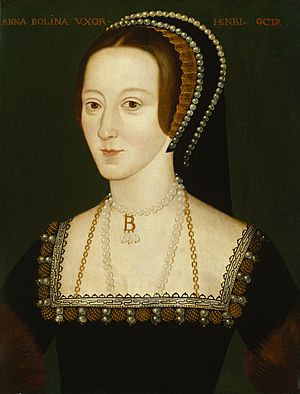
Henry desperately wanted a son to be his heir. By 1527, Henry wanted to end his marriage to Catherine and marry Anne Boleyn. The Roman Catholic Church said he could not get a divorce without the Pope's permission. Henry asked the Pope, but the Pope refused. The Pope said it went against church teachings. Henry blamed his advisor Wolsey for not changing the Pope's mind. He fired Wolsey and planned to put him on trial, but Wolsey died before this happened. After Wolsey, Thomas More became his main advisor. But More also disagreed with the divorce, so he was replaced a few years later by Thomas Cromwell. Henry also chose Thomas Cranmer to be the Archbishop of Canterbury. Henry knew that Cranmer would agree to the divorce, and Cranmer did. The Pope did not know this, so he allowed Cranmer to become archbishop.
A powerful ruler might have forced the Pope to change his mind. However, the most powerful rulers at the time would have opposed the divorce. Catherine's nephew was Emperor Charles V, who ruled the Holy Roman Empire. Catherine also came from Spain, which was the largest Catholic country. In 1534, all attempts to agree on the divorce failed.
Breaking Away from Rome
Henry asked Parliament to pass the Act of Supremacy. This law stated that the king, not the Pope, was the head of the church in England. This created the new Church of England. The Pope was very angry and excommunicated Henry, meaning Henry was thrown out of the Catholic Church. Henry then forced all priests and bishops to accept him as their new leader. Anyone who refused was punished. Among those killed were Thomas More and Henry's old teacher, John Fisher.
Henry himself was not a true Protestant. He wanted the Church of England to be similar to the Roman Catholic Church, but with him in charge. Some Protestants were even executed, like Anne Askew. However, Henry was influenced by people like Thomas Cromwell, Thomas Cranmer, and Anne Boleyn. These people secretly wanted England to become Protestant. The Church of England did not become fully Protestant until the reigns of Edward VI and Elizabeth I.
Monasteries and Money
Henry and Cromwell believed that monasteries, where Roman Catholic monks and nuns lived, had more money and land than they needed. Henry forced the monks and nuns to leave their monasteries. Then, Henry gave their money and land to men who supported him. Most of the men who received this wealth were Protestants. This event was called the dissolution of the monasteries.
Henry's Six Marriages
Henry's desire for a son led him to marry six times. Each marriage had its own story.
Catherine of Aragon
Henry's first wife was Catherine of Aragon. She was older than Henry and had been married to his brother, Arthur. Henry married her shortly after becoming king. They had one daughter, Mary, but no sons who lived. Henry wanted a male heir very badly. He believed his marriage to Catherine was wrong because she had been his brother's wife. He wanted the Pope to annul (cancel) the marriage, as if it never happened. When the Pope refused, Henry broke away from the Roman Catholic Church.
Anne Boleyn
After his marriage to Catherine was annulled, Henry married Anne Boleyn. Anne was younger than Catherine and Henry hoped she would give him a son. However, Anne also had only one daughter, Elizabeth. Henry became unhappy and accused Anne of treason. His loyal official, Thomas Cromwell, helped find people who claimed Anne had been involved with other men. Anne was found guilty and was executed by having her head chopped off.
Jane Seymour
Henry's third wife was Jane Seymour. She soon gave birth to a son named Edward, which made Henry very happy. Sadly, Jane died a few days later. Henry had loved her very much and was deeply saddened by her death. He lost interest in many things and became larger in size. He was angry with Thomas Cromwell when Cromwell suggested he should marry again after Jane's death.
Anne of Cleves
After a while, Henry changed his mind about marrying again. Since he still had only one son, he realized it was a good idea to marry. He agreed to marry Anne of Cleves, a German princess. When Anne arrived, Henry did not think she was as pretty as her pictures. He was not happy with her. Anne was also unhappy, and they agreed to an annulment after only a few months. Cromwell had helped arrange this marriage. Henry was angry with Cromwell and had him executed.
Catherine Howard
Meanwhile, Henry had noticed a young lady at court named Catherine Howard. She was a cousin of his second wife, Anne Boleyn. Henry thought she would be a good wife. Henry and Catherine married in 1540. But Catherine was much younger than Henry and soon grew tired of him. She started to flirt with other men. After they had been married for just over a year, Henry found out that Catherine had been romantically involved with someone else. She was found guilty of treason and executed, just like Anne Boleyn.
Catherine Parr
Henry's sixth and last wife was Catherine Parr. She was in her thirties and had already been married twice. Her first two husbands had been much older and had both died. Henry believed she would be more sensible and loyal than his other wives, and he was right. Catherine Parr remained married to Henry for over three years until he died. They did not have any children together.
Later Years and Legacy
After divorcing Catherine of Aragon, Henry began to suffer from many different health problems. He never fully regained his health. He died on 28 January 1547 at the age of 55 and was buried in Windsor Castle. Henry was the father of two queens and one king: Mary I of England, Elizabeth I of England, and Edward VI of England. None of them had any children of their own.
In 1536, the Act of Union was passed under Henry's rule. This law had a lasting effect on Wales. It meant that Welsh people were encouraged to speak English, and things like road signs were translated into English. The royal family in London was now officially in charge of Wales. However, the Act also gave Welsh citizens the same legal rights as the English, which was a positive change.
Henry's Personality and Interests
Henry often liked to be shown in his portraits with food or pets. He had many pets, including a white pug, and was proud of how his dog showed his wealth.
Henry VIII spent a lot of time at a magnificent building called Hampton Court Palace. It first belonged to his friend, Cardinal Thomas Wolsey. After Henry and Wolsey had a disagreement, Henry took the palace for himself. He made the palace much larger, adding things like tennis courts and jousting yards.
Images for kids
-
The meeting of Francis I and Henry VIII at the Field of the Cloth of Gold in 1520
-
Henry with Emperor Charles V (right) and Pope Leo X (centre), around 1520
-
Catherine of Aragon, Henry's first queen, around 1520.
-
Portrait of Henry VIII by Joos van Cleve, around 1531
-
Portrait of Anne Boleyn, Henry's second queen; a copy of a lost original painted around 1534.
-
Portrait by Hans Holbein the Younger, around 1537
-
Portrait of Anne of Cleves by Hans Holbein the Younger, 1539
-
Portrait of a woman believed to be Catherine Howard, Henry's fifth wife, by Hans Holbein the Younger, 1540
-
Catherine Parr, Henry's sixth and last wife
-
Henry in 1540, by Hans Holbein the Younger
-
Catherine of Aragon watching Henry jousting in her honour after giving birth to a son
See also
 In Spanish: Enrique VIII de Inglaterra para niños
In Spanish: Enrique VIII de Inglaterra para niños



